
Planting Tips: Where Do Magnolia Trees Grow Best?
Published: 07/05/2025 | Updated: 07/05/2025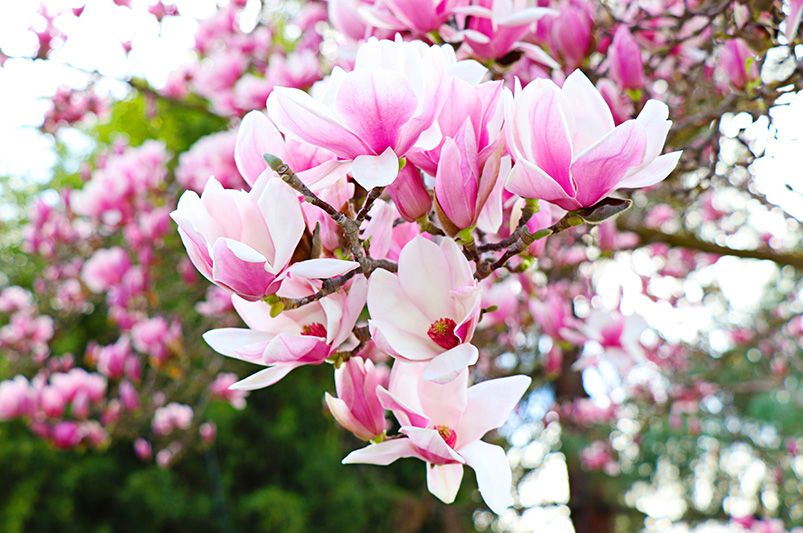
Key Highlights
-
Magnolia trees are available in deciduous and evergreen varieties, offering options for small gardens or sprawling landscapes.


-
They thrive in slightly acidic to neutral soil and require a sunny, sheltered spot for optimal growth.
-
Popular species include Magnolia grandiflora, star magnolia, and southern magnolia, known for their striking flowers and aromatic appeal.
-
Planting is best done in early spring or late winter, ensuring healthy growth through the growing season.
-
Proper care, including watering, pruning, and protection from frost damage, promotes long-term health and flowering potential.
Introduction
The magnolia tree represents southern charm. It has beautiful flowers in shiny whites, bright pinks, and golden yellows. There are two main types of magnolias: deciduous species, which lose their leaves in winter, and evergreen varieties, which keep their leaves all year. Whether you want a big garden or a small area with flair, magnolias can make your space lovely. Pick the right type, plant it well, and take care of it. This way, you can enjoy their amazing beauty every year.
Magnolia Tree Varieties
Magnolias have many kinds and shapes. This makes them suitable for different gardens and climates. You can find them as small shrubs, perfect for smaller spaces. They can also grow into large, beautiful trees that suit bigger areas. Their flowers usually come in pink, white, or magenta. Some special types even have yellow flowers.
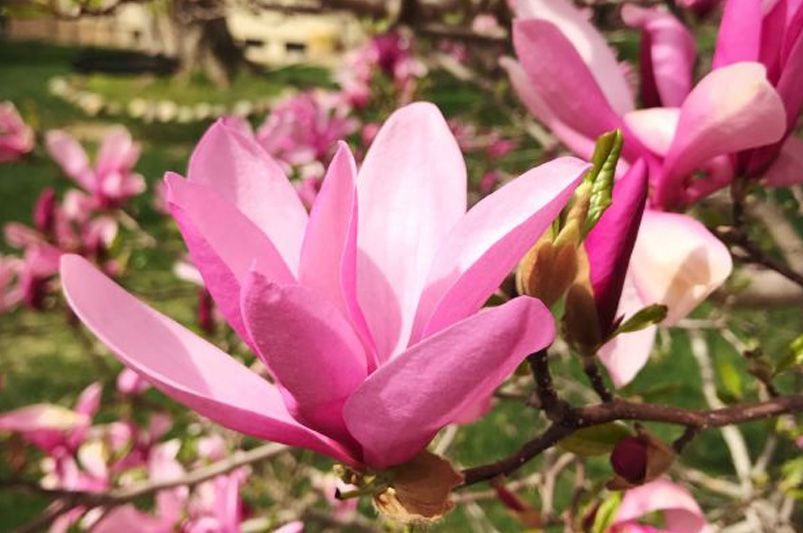
Betty Magnolia
The Betty Magnolia is a striking deciduous shrub or small tree known for its large, tulip-shaped flowers that bloom in rich shades of deep pink to purple with a hint of white on the inside. Part of the "Little Girl" hybrid series, it was specially bred for late spring blooming to avoid frost damage, making it a reliable and resilient choice for a wide range of climates. Betty Magnolia grows to about 10 to 15 feet tall and wide, forming a compact, rounded shape that fits beautifully into residential landscapes. Its vibrant spring blooms and lush green foliage make it a standout ornamental tree that adds year-round interest to gardens and front yards alike.
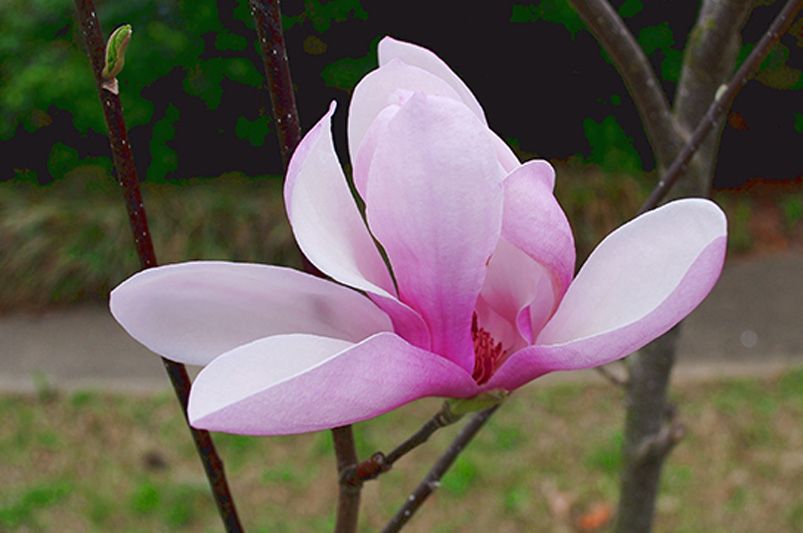
Jane Magnolia
The Jane Magnolia is a charming, cold-hardy hybrid known for its stunning, reddish-purple flowers with soft white interiors that bloom in early to mid-spring. As part of the “Little Girl” series, it was developed to bloom later in the season, reducing the risk of frost damage. This deciduous shrub or small tree typically reaches 10 to 15 feet in height and spread, making it a perfect choice for smaller gardens or accent plantings. With its bold, fragrant blooms and lush green foliage, the Jane Magnolia brings seasonal color and elegance to any landscape, thriving in full sun to partial shade and well-drained soil.
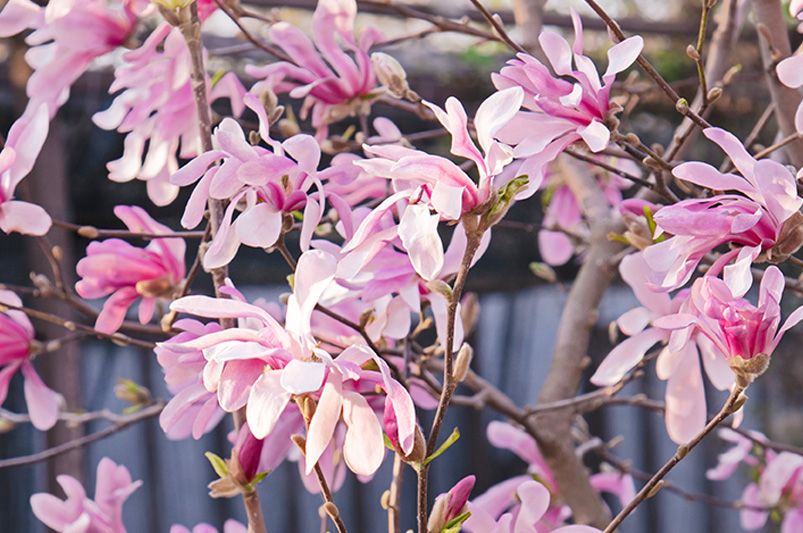
Leonard Messel Magnolia
The Leonard Messel Magnolia is a captivating deciduous tree or large shrub admired for its abundant, star-shaped blooms that appear in early spring. Each delicate flower features soft pink petals with deeper rose-purple undersides, creating a beautiful two-tone effect that stands out in any landscape. A cross between Magnolia kobus and Magnolia stellata, this hardy variety typically grows 15 to 20 feet tall and wide, forming a graceful, upright habit. Its early blossoms often emerge before the leaves, offering a breathtaking floral display, while its vibrant green foliage adds charm throughout the growing season. Ideal for borders, lawns, or specimen plantings, the Leonard Messel Magnolia delivers timeless elegance with reliable performance.
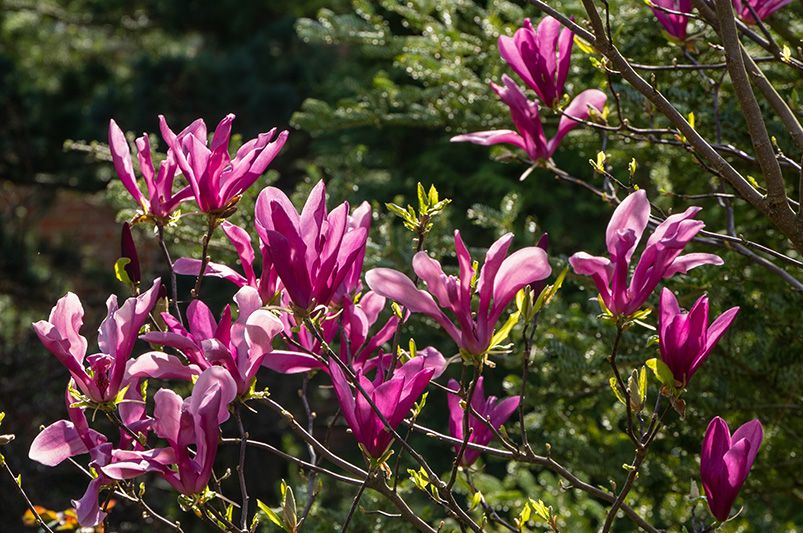
Susan Magnolia
The Susan Magnolia is a standout member of the “Little Girl” hybrid series, prized for its deep reddish-purple, tulip-shaped flowers that bloom in late spring. Designed to avoid early frosts, Susan offers a reliable and prolonged display of vibrant color just as other spring blooms begin to fade. This compact, deciduous shrub or small tree grows to about 8 to 12 feet tall and wide, making it an excellent choice for smaller gardens, foundation plantings, or as a stunning focal point. With its rich color, sweet fragrance, and tidy growth habit, the Susan Magnolia adds lasting beauty and elegance to any landscape.
Optimal Growing Conditions for Magnolia Trees
Magnolia trees grow best in rich, well-draining soil that has a slightly acidic to neutral pH. They like to stay moist but should not sit in water whether they are in the ground or in pots.
These trees thrive in areas with full sun or light shade, away from spots that might get frost or harsh winds. A sheltered spot helps protect their buds and flowers from frost and bad weather. By meeting these important growing needs, gardeners can ensure their magnolia trees do well.
Soil Requirements for Healthy Growth
Magnolias grow best in slightly acidic or neutral soil. This type of soil meets their nutrient needs. It's important that the soil is fertile and drains well. This helps to keep the root system safe from standing water. Magnolia roots are shallow and delicate, so be careful not to hurt them when planting.
A big worry for people who love magnolias is phytophthora root rot. This problem happens in heavy or waterlogged soil. To avoid this, mix clay soil with organic matter or compost. This will help drainage and improve fertility.
In alkaline soil, Magnolia grandiflora can be a good choice. You can add pine needles or acidic mulches to help the soil for other magnolia varieties. Magnolias need good soil health. With the right care, they can bring bright flowers and successful growth to gardens.
Sunlight and Temperature Needs
Magnolias grow well in full sun or light shade. Sunlight is important for many flowers. A place with lots of sun ensures bright blooms. If you plant them in the shade, you might get fewer flowers.
Temperature matters too. Cold climates and frost damage can hurt flowers and leaves. Strong winds can be a problem also. So, always pick a sheltered spot away from strong winds. If your area often has extreme frosts, choose magnolia types that bloom later in spring.
During very hot days, keep the soil moist to protect magnolias from stress. With the right sun and temperature, your magnolia trees will be beautiful for years.
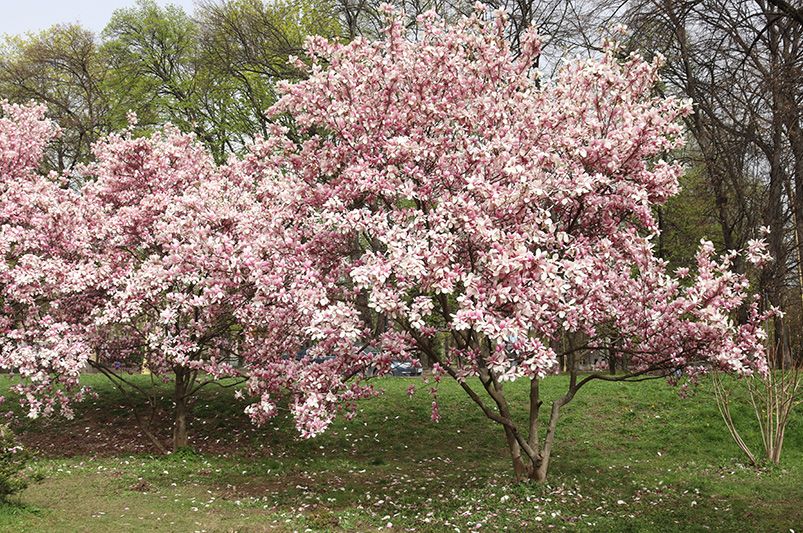
Best Planting Practices for Magnolia Trees
Planting magnolias successfully starts with the right timing and preparing the soil well. Early spring or late winter is the best time. This helps the tree take root before its growing season starts.
You should dig a wide planting hole that matches the size of the root ball. This way, you prevent hurting the fleshy roots. Adding rich compost and using mulch can help the tree grow better. By planting carefully, your magnolia tree can become a beautiful centerpiece in your garden.
When to Plant Magnolia Trees
The best times to plant magnolia trees are early spring and late winter. This is just before the tree starts to grow. Planting during these cooler times helps the roots settle in before summer growth begins.
When you select a spot to plant, stay away from places that often get frost damage or too much water. Magnolias like neutral or slightly acidic soil. You can do a pH test to check if your garden soil is right for them.
Start by preparing the soil. If you’re planting in late winter, make sure the ground is not frozen. Use organic mulch to keep the root zone warm and moist. Good planning and timing are key for a healthy magnolia.
Step-by-Step Guide to Planting
To help magnolia trees grow well, follow these steps:
|
Step |
Description |
|---|---|
|
Prepare Site |
Pick a spot with full sun or light shade. Choose areas that are sheltered and away from frost. Check the soil pH to make sure it is acidic or neutral. |
|
Dig Hole |
Make a planting hole that is wide enough for the root ball. The depth should match the container it came from. Don’t dig too deep. |
|
Place Root Ball |
Gently put the root ball in place. Make sure the graft point is above the soil to prevent it from getting covered. |
|
Add Mulch |
Use acidic mulch, like bark or compost. This helps keep moisture in and protects the soil from changing temperatures. |
|
Water Thoroughly |
Water the tree well, but don’t let it get waterlogged. Keep the soil moist during the early growth stage. |
If you follow these steps, your magnolia will grow beautifully.
Caring for Your Magnolia Tree
Caring for your magnolia is important to keep it healthy. Make sure to water it well during dry times. Using mulch helps to keep the root zone moist, especially in early summer.
Pruning isn't much but is needed to maintain the tree's shape and to remove any damaged branches. A well-cared-for magnolia will give you strong growth and stunning flowers every year.
Watering and Nutrient Guidelines
Magnolias grow well when their roots stay moist. Young trees need regular watering during the first few years to build a strong base. In early summer, potted magnolias need extra care to keep the soil moist.
Use rich compost and slow-release fertilizers to help them grow. Spread general-purpose fertilizers in late winter to help with root development before the growing season.
Watch the soil closely, as too much water can damage their shallow, fleshy roots. With careful watering and feeding, magnolias can reach their best size and health.
Pruning Techniques
Heavy pruning can cause stress for magnolia trees, especially for deciduous magnolias like star magnolia. Instead, you should do light maintenance after their flowering. Remove any damaged or awkward branches. This keeps their shape looking nice and helps save flower buds for next season.
Evergreen magnolias need shaping too. It’s good to remove stems that grow inward each year. If you have big renovation plans, do them over several years. This will help the tree not to feel overwhelmed.
Prune these trees between mid-summer and early autumn. Avoid cutting during colder months, as this can cause sap loss. By following these steps, your magnolias will stay healthy and balanced.
Common Issues and Solutions
Magnolia trees can have some common problems, especially in changing climates. Frost damage can harm young trees, so it's important to find a sheltered spot for them. Pests like the magnolia scale can also affect their growth, so you need to act quickly to protect the flower buds. Fungal diseases, such as phytophthora root rot, can hurt the roots. This highlights the need for using well-draining neutral soil. By fixing these issues early, magnolias can thrive and display their large flowers during the growing season.
Dealing with Pests and Diseases
Young trees can face many pests and diseases. These can affect how they grow and bloom. It is important to check them regularly during the growing season to find problems early. Issues like phytophthora root rot and fungal diseases should be caught in time. Using natural solutions, like neem oil, can help control pests without harming the environment. Also, having well-draining soil and not over-watering can lower the chance of root diseases. Good care helps keep the leaves and flower buds healthy, making the trees look better overall.
How to Handle Frost and Heat Damage
Protecting young trees from frost damage is very important. You can add a layer of mulch around the root zone to help keep the soil warm during cold weather. When it's very hot, make sure to keep the moisture steady. Also, placing potted magnolias in light shade can help reduce stress. Using taller plants as a windbreak can protect them from strong winds. Keep an eye out for signs of stress, such as a lack of flowers or early leaf drop. This way, you can make quick changes to help your magnolias grow well, no matter the conditions.
Landscape Design Tips with Magnolia Trees
Adding magnolia trees to your yard can make beautiful highlights and improve the look of your property. For a smaller garden, you can choose the star magnolia, which is a deciduous species. If you have more space, the southern magnolia is a great option. You can mix magnolias with evergreen shrubs or small flowering plants. This will create contrast and make your garden more interesting during the growing season. It's a good idea to plant them near a sunny wall or in a sheltered spot. This will protect them from strong winds and frost damage, helping them bloom brightly every year.
Using Magnolias as Focal Points
Incorporating magnolia trees into your landscape design can really improve the overall effect. Their big, beautiful flowers and impressive height catch the eye. This makes them great specimen plants. Placing these trees in sunny areas or close to sheltered walls can create a warm atmosphere. Smaller types, like the ‘Little Gem,’ fit perfectly in tight spaces, allowing even small gardens to shine. Choosing the right deciduous magnolia can beautifully enhance nearby plants and make the garden look even better.
Companion Plants for Magnolia Trees
Magnolia trees are beautiful and can do even better with the right plants around them. Some good companion plants are low-maintenance perennials like hostas and ferns. They grow well in the light shade under the tree's wide branches. Adding colorful flowers like azaleas or rhododendrons can make the magnolia's stunning blooms shine even more, especially in early spring and late summer. Small shrubs like lavender not only look nice but can also keep pests away, creating a healthy garden for everyone.
Conclusion
Incorporating magnolia trees into your garden can make it look beautiful all through the growing season. These lovely trees can be evergreen or deciduous. They do best in full sun or light shade, depending on which type. Knowing about common problems like pests and frost damage is important for keeping them healthy. With the right care and good planting conditions, such as neutral soil and a sheltered spot, magnolias can grow well. They will become a stunning focal point in your outdoor space.
Frequently Asked Questions
How fast do magnolia trees grow, and when can I expect them to bloom?
Magnolia growth rates vary by variety—some, like the Southern Magnolia, grow about 1 to 2 feet per year, while others, like the Star Magnolia, grow more slowly. Most magnolias start blooming within 2 to 5 years after planting, with stunning blossoms typically appearing in early spring or late spring depending on the type. With the right care and placement, your magnolia will thrive and bring beauty to your landscape for decades.
Looking to enhance your landscape with a vibrant magnolia tree?
Add timeless beauty and seasonal color to your yard with a stunning magnolia tree! Whether you’re drawn to the bold blooms of a Betty Magnolia or the elegance of a Jane Magnolia, ShrubHub’s expert designers can help you choose the perfect variety and ideal placement for your space. From design to installation, we make it easy to transform your landscape with this iconic flowering tree.


